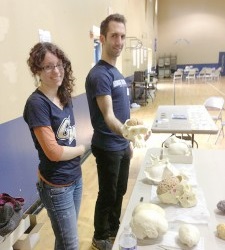Whatever your profession, you may have felt at some point that you were running on automatic pilot. Caught between deadlines and meetings, you run faster and faster in the hope of beating that to-do list that keeps re-writing itself everyday. I often think that, compared to other professions, scientists are lucky in that they can escape monotony through the intellectual challenges strewn in their path. After hours locked up in a lab for weeks on end, however, science can also be socially alienating, and it is easy to lose the big picture. But it does not have to be that way.
Last week I participated in the Neuroscience Experience Week, a public event with the goal of bringing (neuro)science to middle schoolers. This year, participating institutions included Georgetown University, Catholic University, NIDA, NICHD, NIMH, the National Museum of Health and Medicine, and us, the George Washington University. The event was held at the Friendship primary Blow Pierce Junior Academy, a charter school located in Northeast Washington D.C. For a week, the school graciously hosted and welcomed groups of 6th-8th graders coming from all over D.C. to be entertained by the tricks of neuroscientists. Overall, an impressive tally of about 500 kids.
Each day, neuroscientists would show the kids bits and bops of their world: plastic brain models, brains in jars, clips, microscopes, and a lot of enthusiasm. Our lab too had a stand with pictures of brains of different animals, gorilla brain sections, chimpanzee and human brain models, endocasts, several primate skulls, and a couple of real monkey brains that prompted the strongest “ooh…gross” or “ooh…cool” reactions.
My labmates and I had a routine prepared: after welcoming the children, we asked them to match brain pictures to their corresponding animal. We stressed differences in brain size, and shape, and pointed out the animals’ species-specific behavioral specializations. We then drew the kids’ attention to the primate skulls and asked them to gauge how many chimpanzee brains make up a human brain, pointing at the extremely wrinkled surface of the human brain. We ended by showing them replicas of prehistoric tools, such as a chopper and a hand-axe, used by our “less brainy” ancestors.

CASHP postdoc Sarah Barks and student Amy Bauernfeind at the Neuroscience Experience Week
In the 15 minutes allocated to each group of students, we did our best to convey the lesson that the human brain is about three times larger than the chimpanzee’s, and that it changed over millions of years. The kids appeared generally interested, although they also showed amazement for things we had not anticipated, such as discovering that there is a hole at the base of the skull whereby the brain connects with the spine (the one they could put their fingers in it); or learning, in disbelief, that the long snouted skull on our table belonged to a baboon, not a dinosaur. So, whether or not they’ll remember the details of our lesson, I hope some of these kids left with something even more valuable than scientific facts—the curiosity to know more about who we are and where we come from.
I left with the impression that our work as scientists goes well beyond the laboratory walls, and may inspire in manifold ways: like that teenage girl who asked us, “are you in college?”, and smiling back at our affirmative answer, proclaimed: “I want to go to college”.


